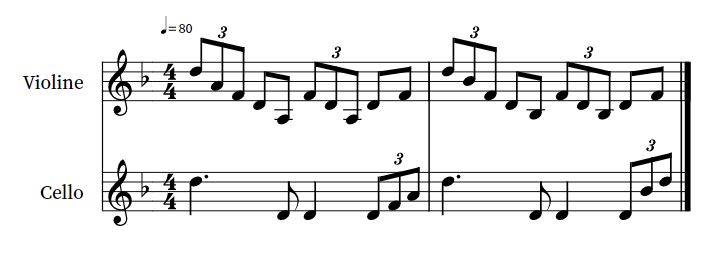Ostinatos seem to have a high value among composers of all different genres, but especially if you are focused on epic orchestration. The term “epic orchestration” might be a bit unspecific, but it describes all different kinds of uplifting, inspirational, and forward-moving scores used in Trailers and written to picture. A key element and signature to those tracks are ostinatos. But how do you find the perfect ostinato for your track?
Depending on the emotion you want to focus on your track, the ostinato might differ. You can categorize them in static, harmonic, and melodic groups with a lot of room for artistic freedom. Being a repeatable part of your track, you should try to make it easy to understand and let your harmonics and melodics through. Ostinatos are a form of filler to boost your track, so the idea is to keep them in the background.
What are Ostinatos?
I don’t like it complicated, and to make it short: Ostinatos are small musical phrases that are repeated persistently. And that’s where the definition ends. When we talk about Ostinatos, we usually mean repetitive quick rhythms played on staccato strings or the piano. In its definition, they stay in the background and are used as a filler to step the broad sound up.
Usually, the pattern repeats itself every bar and consists of 8th or 16th notes. Strings work really well because they are versatile and flexible and can play quick sessions really easily. A tuba, on the other hand, would be a horrible choice for a fluent ostinato. But of course, you can use other instruments too. Besides the epic orchestration, nearly every lovesong ever written for the film has at some point a big ostinato played by a piano. Due to the emotion it wants to portray, the rhythm is way slower than in epic fantasy. The slower pace and the sound of the piano make it very romantic and dreamy.
Rhythmic Ostinatos
Ostinatos don’t always follow a melody or chords; sometimes, it is enough to have a repeatable beat that gives your track a good drive. Percussions are usually a consistency of ostinatos, with slight variations throughout the entire track. But a rhythmic ostinato can also be played by all other instruments in the orchestra. I really like staccato strings to play a short rhythmic signal, but of course, percussions work too. In a pure rhythmic ostinato usually aren’t any interval changes, but of course, the notes change to match the chord.
In this case, I used a really simple rhythm for the staccato strings. They give the track an uplifting and kind of marching emotion, which can be used perfectly as a buildup to the Grandioso.


This time I used a small percussion section to demonstrate the difference between a purely atonal percussion-based ostinato and a rhythmic ostinato played by other orchestra members. This rhythm can, of course, played by any instrument or FX imaginable. Lately, E-Guitars are used very often for rhythmic ostinatos.
The V-Shape
Whenever someone talks about ostinatos, this is the form most people have in mind. It is usually played on celli and follows the root notes of the cord up and down the scale. The V-Shape is played with a consistent rhythm in 8th or 16th.

This ostinato can be placed down with different durations of ½ bar, 1 full bar, 2 bars, etc. and can have a range of a few notes or entire octaves. But at the end this ostinato is very common and does not win you a gold medal. But due to its simplicity its really effective when you already have complex harmonics or melodies. It blends really easy in the background and if you want keep it simple it is a good choice.
The Slab
This version is really similar to the V-Shap but instead of bringing in all the notes of a chord, it contains only one interval. The phrase consists of only two or four notes, therefore this form gets repeatet very quickly.

In this case, I chose the slap-ostinato to be played in 4 16th. You can find this version in nearly every action score. Because of its simplicity, it can be build in really easy and it immediately creates tension. A famous score would be Batman by Hans Zimmer, where entire tracks consist of this simple musical idea.
An other possibility would be to change the pitch thoughout the motif. In this case I changed it every bar, but I stayed always within the chord.
The Saw-Blade
As the name suggests, the notes from a Saw-Blade are following the notes of the chords. Generally speaking, the saw blade just takes the chord and forms a pattern around them. They can be quite close or stretched out over more than one octave. Like the V-Shape, the Saw Blade is quite widely used. It fits perfectly with melodies with a strong beat or melodies that need a strong regular beat.

The Saw Blade really shines when played on the piano widely stretched out.
Counter-Rhythm
Sometimes it is worth a try to write the ostinato as a rhythmical counter to the rest of the track. In this case the main track is written in straigt 4th and 8th . Therefore I wrote the ositnatos in triplets. It can get confused really fast and it is a great filler, if you have a more simple structure in your track. The different motion between triplets and straigt 8th makes it interesting to listen to.

If you speed the triplets up, it becomes a really fast glissando and can be used in the final part to add an extra layer without adding new instruments.
Melodic Ostinatos
Eventhou ostinatos are commonly simple musical patterns, they can also be a bit complex. In this case I combined rhythmic and melodic signals and I even wrote a small countermelody. If you listen to the celli, you can hear how they are playing triplets against the violins at some parts. This form repeats itself every bar.The difference between the ostinato and the countermelody played by the horns, is, that the ostinato gets repeated every bar. The French horn meanwhile plays its own melody over the entire duration of the motif.


